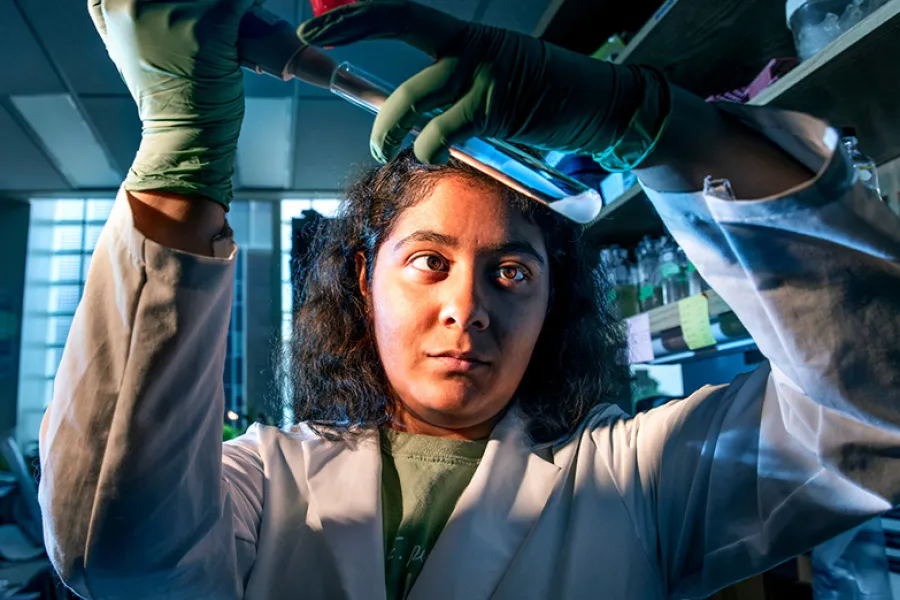CHAMPAIGN, Ill. — It’s 2 a.m. on a cold winter night. My timer beeps loudly, waking me up for yet another measurement. It’s been a long day; I’ve been tracking bacterial growth every two hours for the past 18 hours. I stumble off the couch that has served as a bed for countless graduate students before me. I go to my lab bench, pick up the test tubes that I need for my samples, and groggily set off to the incubation room.
A blast of warm air greets me as I enter the 37 °C room.
My samples slosh on an oscillating platform. This sloshing ensures that the bacteria get plenty of oxygen. I look at my samples one by one. The liquid is getting cloudier, a sign that the bacteria are growing.
With a pipette that looks like a plastic straw, I draw out small volumes of the samples, less than a quarter of a teaspoon each, and put them in the test tubes. I go back to my lab. I need to use a better instrument than my eyes to check whether the cloudiness has actually increased or whether my sleepy mind is playing tricks on me.
I use a spectrophotometer, which measures how much light passes through a sample. Cloudy samples allow less light to pass through. The instrument agrees with me: The bacteria are growing.
Tracking the growth of bacteria is a useful way to check whether these organisms can survive in the conditions that researchers impose on them. In my experiments, I play with the lives of the bacteria Escherichia coli by stressing them out with hydrogen peroxide.
Hydrogen peroxide is commonly used as an antiseptic to clean wounds. It works because it is mildly toxic: capable of damaging several processes inside cells. For example, it poisons some of the enzymes that help make amino acids, the building blocks of proteins.
Our cells take advantage of this effect. Our white blood cells produce hydrogen peroxide to kill invading bacteria. However, bacteria have several ways to protect themselves. These defenses are especially important in bugs like Salmonella, which can resist the killing effect of white blood cells.
My job is to understand one such defense mechanism in E. coli that protects its enzymes from hydrogen peroxide damage. Researchers often use E. coli to study biological processes because it is easy to work with and because what is true in E. coli often turns out to be true in other organisms, including humans.
All my experiments revolve around measuring things that are invisible to the human eye. A single E. coli cell is 2 micrometers in length. You would have to line up 25 such cells end-to-end for it to add up the width of a single human hair. If E. coli is that small, imagine how much smaller its enzymes are. Therefore, I use specialized equipment that helps me track its growth and the state of its enzymes.
E. coli has several weapons, in the form of proteins, that it uses to defend itself. My job is to strip it of these weapons to see which ones are important against hydrogen peroxide stress. For example, if protein X is useful, deleting it will make cells grow poorly during the stress, leading to lower cloudiness compared with cells that have that protein. Similarly, if I want to check whether certain enzymes are being poisoned, I measure their activity in a spectrophotometer. The lower the signal, the lower the activity.
When I work in lab, all I usually see are the colorless solutions that I mix together. I essentially take a leap of faith that I have mixed all the correct chemicals and cells in the right proportions and order. I know the experiments have worked when the numbers on my instruments tell me so. Successful experiments are worth the sleepless nights I spend dissecting the processes in living things that are essentially invisible to us.
+++
Photo caption: Ananya Sen stresses bacteria with hydrogen peroxide to learn about bacterial defenses.
Image by Fred Zwicky
Ananya Sen is a graduate student in the laboratory of microbiology professor James Imlay.
Story by Ananya Sen, reposted from the Illinois News Bureau (July 22, 2019).
Subscribe to Behind the Scenes for short blog posts, photos and videos from Illinois faculty, researchers, students and staff about their work and lives. Send an email with “SUBSCRIBE BTS” in the subject line.
